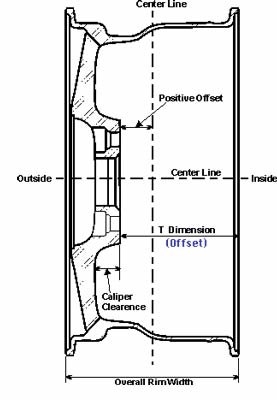
Width – What most people don’t realize is that the published width of a wheel is not the actual width.
For example: A 6″ wheel is 6″ wide where the tire mounts, but is actually 7″ wide edge to edge.
Offset – Wheels are normally designated by “offset” shown in millimeters as ET on the wheel. As it implies, offset is how much the mounting surface is offset from the center line of the width toward the face of the wheel.
Backspace – It is usually more instructive the look at wheels in terms of “backspace” rather that offset (shown as the “T” dimension on the drawing to the right.) Backspace will tell you how far the wheel will fit under the fender. When fitting larger wheels and tires it is important to know the maximum backspace a chassis will accept.
Let’s take the example of a 6″ wheel with 19mm ET. The wheel is actually 7″ wide, so zero offset (center line) would be a backspace of 3-1/2″. The ET of 19mm is about 3/4″
Therefore, 3-1/2″ + 3/4″ equals 4-1/4″ …
So a 6″ wheel with a 19mm offset has a backspace of about 4–1/4”. Similarly a 7” wheel with a 20mm ET has a backspace of about 4-3/4″.
The BMW 2002 Wheel Size and Tire Fitment
The best backspace for our beloved BMW 2002 is just over 4-1/2″. This allows the tire to be under the car as far as possible to allow the most room at the fender lip for larger tires. The tire rubbing on the strut housing is the limiting factor for backspace, but the tie rod end is also a consideration on 13″ wheels. It is not a problem to use wheels with a backspace of more than 4-1/2” with a spacer. This can actually work well as it allows you to adjust the tire in the wheel well for the best clearance. There are very few wheels available with the correct backspace for the 2002 but plenty of wheels with the deeper front wheel drive backspaces. We do this all the time on our racecars. I normally do not use spacers more than 1/2” thick. If using spacers, make sure you have long enough studs to have at least 1/2″ (8 turns) of thread in the lug nuts.
Many 2002 owners use the 14″ wheel from the 1984-1991 3 series (E30) in 14×6 or 14×6.5. These work well but may need a small 1/8″ or 1/4″ spacer at the front. A tire size of 195x60x14 works well. Larger tires usually require adjustments to the fender. Our easy to install “turbo” flares are a common solution the fender clearance issues.
15″x7″ wheels with a 20mm offset are available and are best used with 195x50x15 tires. Larger tires up to 225 will fit the rim but fender modification or flares will be needed.
Wheels from the 1977 to 1982 320i (e21 chassis) do not have enough offset or backspace to fit properly on the 2002. The tires will tend to rub the fender lip. They can be made to work with narrow tires if the car has not been lowered.
BMW E30 Chassis Wheel Size and Tire Fitment
The factory BMW 14×6 wheels — which we refer to as “bottle caps” — are ET 35, so the backspace is 4.875″. The basket weave “sport” wheels are 14×6.5 with an ET of 30. So the backspace on these is 4.93″. It is very common to use 7″ wide wheels on the E30 in 15″, 16″ or 17″ diameters. The ideal ET for a 7″ wheel is 25mm, as this gives a backspace of 5″. We have had no problems fitting 17×7 wheels with 225mm tires on the E30’s. Beware of wheels that are very flat on the back side. If the spokes are too close to the mounting surface the spokes may hit the brake calipers. Note the 15” wheel from the 325ix do not fit regular E30’s.
The E30’s came with wheel bolts rather than studs. We like to switch to studs as it makes it much easier to change wheels.

